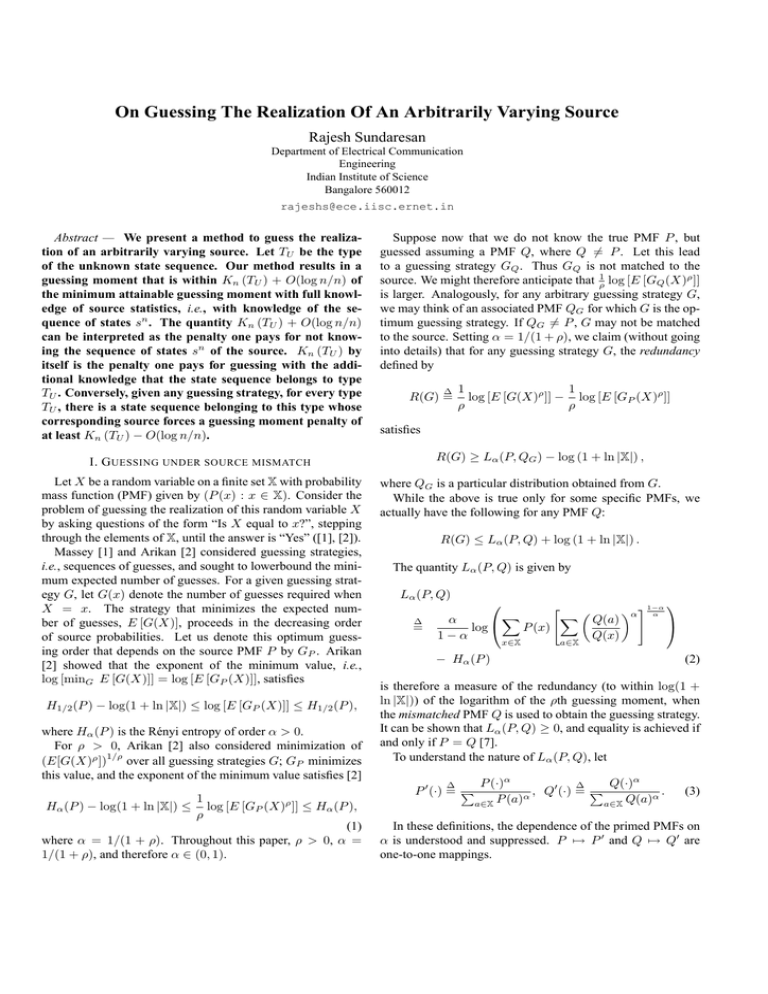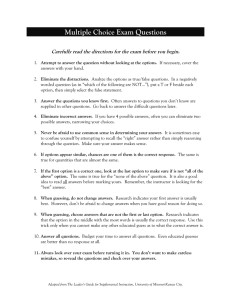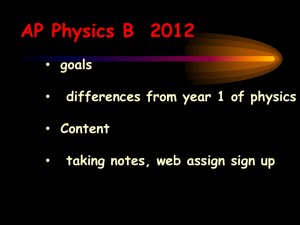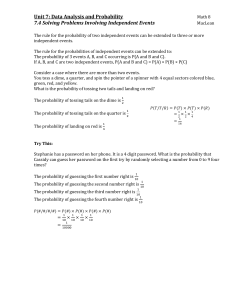On Guessing The Realization Of An Arbitrarily Varying Source Rajesh Sundaresan
advertisement

On Guessing The Realization Of An Arbitrarily Varying Source Rajesh Sundaresan Department of Electrical Communication Engineering Indian Institute of Science Bangalore 560012 rajeshs@ece.iisc.ernet.in Abstract — We present a method to guess the realization of an arbitrarily varying source. Let TU be the type of the unknown state sequence. Our method results in a guessing moment that is within Kn (TU ) + O(log n/n) of the minimum attainable guessing moment with full knowledge of source statistics, i.e., with knowledge of the sequence of states sn . The quantity Kn (TU ) + O(log n/n) can be interpreted as the penalty one pays for not knowing the sequence of states sn of the source. Kn (TU ) by itself is the penalty one pays for guessing with the additional knowledge that the state sequence belongs to type TU . Conversely, given any guessing strategy, for every type TU , there is a state sequence belonging to this type whose corresponding source forces a guessing moment penalty of at least Kn (TU ) − O(log n/n). Suppose now that we do not know the true PMF P , but guessed assuming a PMF Q, where Q 6= P . Let this lead to a guessing strategy GQ . Thus GQ is not matched to the source. We might therefore anticipate that ρ1 log [E [GQ (X)ρ ]] is larger. Analogously, for any arbitrary guessing strategy G, we may think of an associated PMF QG for which G is the optimum guessing strategy. If QG 6= P , G may not be matched to the source. Setting α = 1/(1 + ρ), we claim (without going into details) that for any guessing strategy G, the redundancy defined by ∆ R(G) = satisfies R(G) ≥ Lα (P, QG ) − log (1 + ln |X|) , I. G UESSING UNDER SOURCE MISMATCH Let X be a random variable on a finite set X with probability mass function (PMF) given by (P (x) : x ∈ X). Consider the problem of guessing the realization of this random variable X by asking questions of the form “Is X equal to x?”, stepping through the elements of X, until the answer is “Yes” ([1], [2]). Massey [1] and Arikan [2] considered guessing strategies, i.e., sequences of guesses, and sought to lowerbound the minimum expected number of guesses. For a given guessing strategy G, let G(x) denote the number of guesses required when X = x. The strategy that minimizes the expected number of guesses, E [G(X)], proceeds in the decreasing order of source probabilities. Let us denote this optimum guessing order that depends on the source PMF P by GP . Arikan [2] showed that the exponent of the minimum value, i.e., log [minG E [G(X)]] = log [E [GP (X)]], satisfies H1/2 (P ) − log(1 + ln |X|) ≤ log [E [GP (X)]] ≤ H1/2 (P ), where Hα (P ) is the Rényi entropy of order α > 0. For ρ > 0, Arikan [2] also considered minimization of 1/ρ (E[G(X)ρ ]) over all guessing strategies G; GP minimizes this value, and the exponent of the minimum value satisfies [2] 1 log [E [GP (X)ρ ]] ≤ Hα (P ), ρ (1) where α = 1/(1 + ρ). Throughout this paper, ρ > 0, α = 1/(1 + ρ), and therefore α ∈ (0, 1). Hα (P ) − log(1 + ln |X|) ≤ 1 1 log [E [G(X)ρ ]] − log [E [GP (X)ρ ]] ρ ρ where QG is a particular distribution obtained from G. While the above is true only for some specific PMFs, we actually have the following for any PMF Q: R(G) ≤ Lα (P, Q) + log (1 + ln |X|) . The quantity Lα (P, Q) is given by Lα (P, Q) ∆ = α log 1−α X x∈X " P (x) X µ Q(a) ¶α a∈X # 1−α α Q(x) − Hα (P ) (2) is therefore a measure of the redundancy (to within log(1 + ln |X|)) of the logarithm of the ρth guessing moment, when the mismatched PMF Q is used to obtain the guessing strategy. It can be shown that Lα (P, Q) ≥ 0, and equality is achieved if and only if P = Q [7]. To understand the nature of Lα (P, Q), let ∆ P 0 (·) = P P (·)α Q(·)α ∆ 0 P , Q (·) = . α α a∈X P (a) a∈X Q(a) (3) In these definitions, the dependence of the primed PMFs on α is understood and suppressed. P 7→ P 0 and Q 7→ Q0 are one-to-one mappings. Straightforward algebra results in Lα (P, Q) = 1 log [If (P 0 ||Q0 )] , ρ (4) where If (R||S) is the f -divergence with f (x) = x1+ρ (see for e.g., [4]) given by µ ¶ X R(x) If (R||S) = S(x)f . (5) S(x) x∈X Furthermore, we have Lα (P, Q) = ∞ if and only if Support(P ) 6⊂ Support(Q). (Note that α ∈ (0, 1)). We emphasize that Lα (P, Q) is not a convex function of P or of Q. Moreover, unlike f -divergences, Lα (P, Q) does not satisfy the data processing inequality. However, Lα (P, Q) does satisfy a Pythagorean-type inequality and behaves like “squared-distance”. This property was explored in detail in [7]. II. A FINITE FAMILY OF SOURCES Suppose now that (Pθ : θ ∈ Θ) is a one-parameter family of sources on the finite alphabet set X. The family is of finite size, i.e., |Θ| < ∞. (In recent work, we have been able to extend some of the results of this section to families of infinite sizes with some mild regularity conditions on the family [8]. This however is beyond the scope of this paper). The true source is one from the family, but is otherwise unknown. A guessing strategy for the above family of sources can be devised as follows. Let Gθ be the guessing order when Pθ is known to be the source. (Note that Gθ is short form for the more cumbersome GPθ ). Now merge these |Θ| guessing lists as follows: • First order the elements in Θ and call them θ1 , · · · , θ|Θ| . • Set i = 1. • List elements of X in the following order: ith element of Gθ1 , then the ith element of Gθ2 , and so on, skipping an element if it is already in the list, until the ith element of Gθ|Θ| is reached. • Once done with all ith elements, increment i, and continue, until all elements are listed. An important property of this list is that G(x) ≤ |Θ|Gθ (x), for every x ∈ X and for every θ ∈ Θ. Note that this is a strategy that does not depend on the parameter θ. We therefore have the following result. Define the penalty function for an arbitrary guessing function G as follows: ∆ R(θ, G) = 1 1 log [Eθ [G(X)ρ ]] − log [Eθ [Gθ (X)ρ ]] , ρ ρ where Eθ is expectation with respect to Pθ . Proposition 1 For the finite family (Pθ : θ ∈ Θ), the guessing strategy G obtained by merging the individual guessing lists suffers a maximum penalty which is upperbounded by max R(θ, G) ≤ log |Θ| + log(1 + ln |X|). θ∈Θ Now suppose that we wish to do better for this family of sources. One approach is to find a Q∗ that comes close to K = inf max Lα (Pθ , Q), Q θ∈Θ (6) where the infimum is over all PMFs on X. We can think of K in (6) as playing the geometric role of minimum radius enclosing all points Pθ in the family, measured from the center Q∗ . This minimum radius is termed the “Lα -radius” of the family (Pθ : θ ∈ Θ), because “squared-distances” are given by Lα (·, ·). We caution that Lα (·, ·) is not a distance function or a metric in the strict sense. Indeed, it is not symmetric in the two arguments. From (4) and the monotone increasing property of log(·), the problem in (6) is straightforwardly transformed into the problem of finding the “If -radius” and “If -center” of the family (Pθ0 : θ ∈ Θ), i.e., K 0 = inf0 max If (Pθ0 , Q0 ). Q θ∈Θ (7) See [4] for a solution to the problem, and also [5] and [6] for related problems. The problem transformation is done by using the mapping Pθ 7→ Pθ0 and the relationship in (4). Results of [5], [4] and[6] show that the “inf” in (6) can be replaced by a “min”, and therefore K 0 = min max If (Pθ0 , Q0 ). 0 Q θ∈Θ (8) The minimizing Q∗ can be found from the inverse mapping of Q∗ 7→ Q0∗ where Q0∗ is the “If -center” of the family (Pθ0 : θ ∈ Θ). Furthermore, [7] indicates that this minimizing Q∗ is a mixture of the sources that make up the family, i.e., X Q∗ = w(θ)Pθ . θ∈Θ This property is a consequence of the Pythagorean-type inequality satisfied by Lα (P, Q). It can also be seen from the results in the following section. Thus the “inf” in 6 can also be replaced by “min”. Returning to the problem of finding a guessing strategy for the family of sources, we can guess in the decreasing order of probabilities given by the PMF Q∗ , which then leads to the following result. Proposition 2 For the finite family (Pθ : θ ∈ Θ), let Q∗ be the Lα -center, and K the Lα -radius. Let GQ∗ be the guessing strategy obtained by guessing in the decreasing order of probabilities of Q∗ . Then the maximum penalty suffered by the strategy is upperbounded by the following: to such a source. The guessing exponent is normalized by n, and the additional terms go to 0 for large n, and are given by max R(θ, GQ∗ ) ≤ K + log (1 + ln |X|) . 1 log (1 + ln |X|n ) = O(log n/n). n θ∈Θ Furthermore, for any guessing strategy G, we have max R(θ, G) ≥ K − log (1 + ln |X|) . θ∈Θ III. N ECESSARY AND SUFFICIENT CONDITIONS FOR FINDING THE CENTER AND RADIUS The needed results from [4] for finding If -center and If radius are first reproduced. These can then be easily transformed to find the Lα -center and Lα -radius. Csiszar [4] shows that X K 0 = min max If (Pθ0 , Q0 ) = max min v(θ)If (Pθ0 , Q0 ). 0 0 Q v θ∈Θ Q θ∈Θ C is a normalizing constant. Also, v ∗ attains the maximum in (9) if and only if If (Pθ0 , Q0∗ ) ≤ K 0 , ∀θ ∈ Θ, (11) where equality holds whenever v(θ) > 0. We make one remark and close this section. By using the inverse of the mapping P 7→ P 0 on the minimizing Q0∗ , we get that X Q∗ = w(θ)Pθ , θ∈Θ w(θ) = A £P V. A RBITRARILY VARYING S OURCES Consider a finite state arbitrarily varying source (AVS) characterised by the PMF Psn (xn ) = θ∈Θ (9) Furthermore, for any given v, the minimizing Q0∗ is given by à !α X 1/α 0 0∗ v(θ) [Pθ (x)] Q (x) = C , ∀x ∈ X. (10) where The results in the previous section on redundancy are for a finite number of sources in the family. However, Arikan and Merhav [3] show a universal guessing strategy that works for all iid sources with unknown P . Furthermore, the proof of their result indicates that the redundancy suffered by their universal guessing strategy is at most O(log n/n), for any iid source. In the next section, we look at a more general class of independent, but not identically distributed set of sources. v(θ) ¤ , 1/α α a∈X Pθ (a) where A is a normalizing constant. This means that the optimizing Q∗ is a mixture of the sources in the family, a result that is obtained in aP more geometric and intuitive setting in [7]. Also note that if a∈X Pθ (a)1/α is independent of θ, then v = w. IV. I NDEPENDENT AND I DENTICALLY D ISTRIBUTED S OURCES Consider now the problem of guessing the n-length realization of an independent and identically distributed (iid) source. Suppose that each component has a PMF P . Further suppose that guessing is done assuming a mismatched joint PMF. The results of the previous section are straightforwardly extended n Y Psi (xi ), i=1 where xn is the source sequence to be guessed, and sn = (s1 , · · · , sn ) is an unknown arbitrary sequence of states. Each si takes values from a finite set S. This is a fairly large class of sources for which we would like to build a guessing strategy. We follow a hierarchical approach to keep the redundancy at a minimum. Let U be a rational PMF on S where the rationals have denominator n. The set TU is a subset of Sn whose elements have an empirical PMF equal to U . We then say that a sequence belonging to TU has type TU . The number of distinct types is upperbounded by (n + 1)|S| because the occurrence of each letter takes at most n + 1 values. Let us first assume that sn belongs to TU for some U . The following proposition, the main result of this paper, tells us how to arrive at a guessing strategy that gives the minmax penalty. Proposition 3 The normalized Lα -radius Kn (TU ) for the family of sources with state sequence belonging to TU is given by Kn (TU ) = min max n Q s ∈TU 1 1 Lα (Psn , Q) = [Hα (Q∗ ) − Hα (Psn )] , n n where Q∗ = X sn ∈TU 1 P sn |TU | is the uniform mixture. Proof Outline: We first observe that for every sn ∈ TU , the quantity X Psn (xn )α xn ∈Xn does not depend on the specific sn . A simple permutation argument suffices to show this. This implies that the weights w that lead to the Lα -center are the same as the weights v that lead to the If -center, as observed in Section III. Next, we check that the weights w(sn ) = v(sn ) = 1/|TU | satisfy the sufficient condition that If (Ps0n , Q0∗ ) is a constant independent of sn (given that it belongs to TU ). To see this, we first write X If (Ps0n , Q0∗ ) = Ps0n (xn )1+ρ Q0∗ (xn )−ρ xn ∈Xn P = Psn (xn )Q0∗ (xn )−ρ (12) ¤ n 1/(1+ρ) 1+ρ xn ∈Xn Psn (x ) xn ∈Xn £P The quantity Q0∗ (xn ) is obtained from (10) and is given by à !α X 1 0∗ n 0 n 1/α Q (x ) = C1 [P (x )] |TU | θ sn ∈TU !α à X 1 = C2 Pθ (xn ) . |TU | n s ∈TU A permutation argument yields that this quantity depends on xn only through the type of the sequence xn . We can then use these facts to show that both the numerator and denominator of (12) do not depend on sn , when sn ∈ TU . An evaluation then leads to the proposition. Details are available in [8]. ¤ The above Proposition along with Proposition 2, indicates that for every type TU , and for any guessing strategy G, we can find a state sequence sn for which R(sn , G) ≥ Kn (TU ) − O(log n/n). We next consider the case when the type of the state sequence is not known. Within each type, we have found the penalty for a guessing strategy that depends only on the type of the state sequence. We then merge these lists according to the strategy used to prove Proposition 1. Since there are at most (n + 1)|S| types, this leads to an extra penalty of O(log n/n). We therefore have the following result. Proposition 4 For the finite-state AVS, there is a guessing strategy that does not depend on the state sequence, and whose penalty for a source with state sequence sn belonging to TU is upperbounded by Kn (TU ) + O(log n/n). Properties of Kn (TU ) are under investigation. R EFERENCES [1] J.L.Massey, “Guessing and entropy,” in Proc. 1994 IEEE Int. Symp. on Information Theory (Trondheim, Norway, 1994), p. 204. [2] E.Arikan, “An inequality on guessing and its application to sequential decoding,” IEEE Trans. Inform. Theory, vol. IT-42, pp. 99-105, Jan. 1996. [3] E.Arikan and N.Merhav, “Guessing subject to distortion ”, IEEE Trans. Inform. Theory, vol. IT-42, pp. 1041-1056, vol. 44, no.3, May 1998. [4] I.Csiszar, “A class of measures of informativity of observation channels,” Periodica Mathematica Hungarica, vol. 2, pp. 191-213, 1972. [5] I-Csiszar, “Generalized cutoff rates and Rényi’s information measures”, IEEE Trans. Inform. Theory, vol. IT-41, pp. 26-34, Jan. 1995. [6] R.Sibson, “Information radius”, Z. Wahrscheinlichkeitstheorie verw. Geb., vol.14, pp. 149-160, 1969. [7] R.Sundaresan,“A measure of discrimination and its geometric properties”, Proceedings of the 2002 IEEE International Symposium on Information Theory, p. 264, Lausanne, Switzerland, June 2002. [8] R.Sundaresan, “Guessing under source uncertainty”, manuscript under preparation, December 2005.






